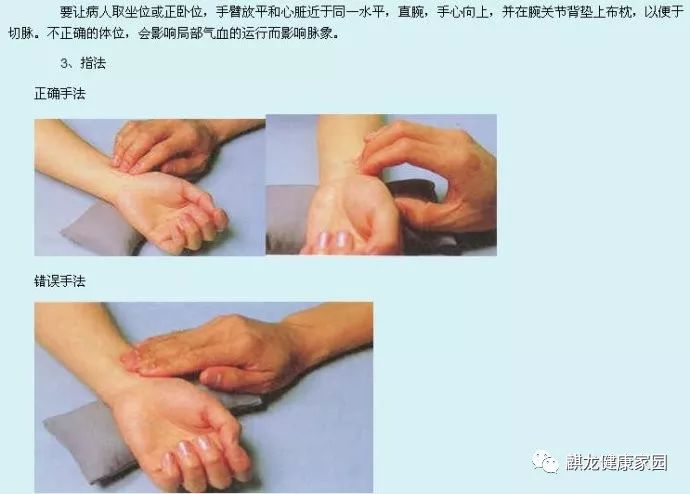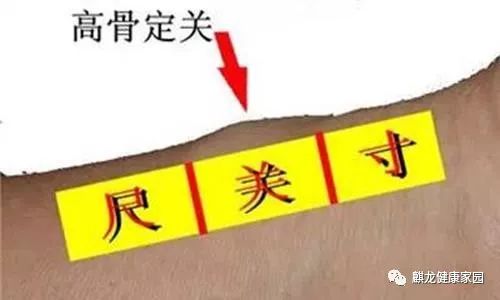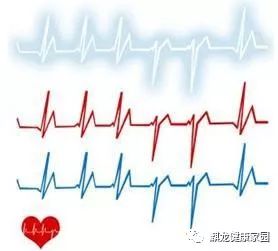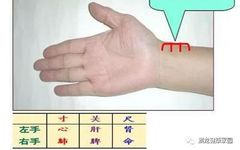

Pulse diagnosis is a method of examining the pulse at the wrist (cun kou) to observe changes in the pulse pattern. Clinically, it is essential to master the timing of pulse diagnosis, the patient’s position, the physician’s finger techniques, and the pressure applied. Each pulse examination should last until each side’s pulse beats at least 50 times. Additionally, understanding the variations in the pulse of healthy individuals is crucial for accurate diagnosis.
Pulse Diagnosis Locations
The cun kou is divided into three sections: cun (寸), guan (关), and chi (尺), marked by the styloid process of the radius. The area slightly inward from this point is the guan, the area at the wrist (distal) is the cun, and the area at the elbow (proximal) is the chi. Each hand has three sections, making a total of six pulse locations. The cun, guan, and chi can be further divided into three states: superficial (浮), middle (中), and deep (沉), which are the three sections and nine states of the cun kou diagnosis method. The cun, guan, and chi correspond to different organs, with varying interpretations by historical practitioners. Currently, the following is commonly accepted:Left cun corresponds to the heart and zhong (膻中); right cun corresponds to the lung and chest; left guan corresponds to the liver and gallbladder; right guan corresponds to the spleen and stomach; left chi corresponds to the kidney and lower abdomen; right chi corresponds to the kidney and lower abdomen.
The cun, guan, and chi correspond to different organs, with varying interpretations by historical practitioners. Currently, the following is commonly accepted:Left cun corresponds to the heart and zhong (膻中); right cun corresponds to the lung and chest; left guan corresponds to the liver and gallbladder; right guan corresponds to the spleen and stomach; left chi corresponds to the kidney and lower abdomen; right chi corresponds to the kidney and lower abdomen.
Pulse Diagnosis Methods
1. Time and EnvironmentThe best time for pulse diagnosis is in the morning, as patients are less affected by food, activity, and other factors, and the internal and external environments are relatively calm. This allows for easier identification of pathological pulses. However, pulse diagnosis can also be performed at other times. Generally, a quiet environment is required. Before diagnosis, the patient should rest briefly to calm the qi and blood, and the physician should also maintain a calm demeanor. The examination room should be quiet, and then pulse diagnosis can begin. In special circumstances, diagnosis can be conducted anytime and anywhere without strict adherence to these conditions.2. PositionThe patient should be seated or lying flat, with the arms resting at heart level, the wrists straight and palms facing up, and a cushion placed under the wrist joint. This allows for unobstructed qi and blood flow, reflecting the true pulse condition of the body. 3. Finger TechniquesThe physician and patient sit side by side, with the left hand examining the patient’s right hand and the right hand examining the patient’s left hand. When examining the pulse, the middle finger is placed on the inner side of the guan pulse position, the index finger on the cun pulse position, and the ring finger on the chi pulse position. Once the positions are correctly placed, the three fingers should form a bow shape, with the fingertips aligned, using the pads of the fingers to contact the pulse.
3. Finger TechniquesThe physician and patient sit side by side, with the left hand examining the patient’s right hand and the right hand examining the patient’s left hand. When examining the pulse, the middle finger is placed on the inner side of the guan pulse position, the index finger on the cun pulse position, and the ring finger on the chi pulse position. Once the positions are correctly placed, the three fingers should form a bow shape, with the fingertips aligned, using the pads of the fingers to contact the pulse. The spacing of the fingers should correspond to the patient’s height; taller individuals should have wider spacing, while shorter individuals should have closer spacing, always maintaining moderation. The three fingers should apply simultaneous pressure on the pulse, known as total pressure; to focus on a specific pulse, one finger can be lifted slightly while examining that pulse. For example, to focus on the cun pulse, slightly lift the middle and ring fingers; for the guan pulse, slightly lift the index and ring fingers; for the chi pulse, slightly lift the index and middle fingers. In clinical practice, total and single pressure are often used in combination, making this comparative method of pulse diagnosis quite practical. Single pressure can be used to assess the three sections of the cun kou to determine which meridian and organ are affected, while total pressure is used to examine the changes in the five zang and six fu organs.For pediatric pulse diagnosis, the “one-finger (thumb) method” can be used, without subdividing into three sections, as the cun kou area in children is short and does not allow for three fingers to be placed.4. Lifting and PressingThis technique involves varying the pressure and movement of the fingers to explore the pulse pattern. The key to pulse diagnosis involves three actions: lifting (举), pressing (按), and searching (寻). Light pressure on the skin is called lifting (浮取); heavy pressure between the muscles and bones is called pressing (沉取); and moderate pressure that is neither light nor heavy is called searching (寻). Therefore, it is essential to observe the changes in the pulse pattern during lifting, pressing, and searching. Additionally, when the three pulse sections show discrepancies, the finger positions must be gradually adjusted to explore further.5. CalmnessEach breath cycle is counted as one breath. During pulse diagnosis, the physician’s breathing should be natural and even, using the time of one breath to count the patient’s pulse beats (frequency), including normal and pathological pulse patterns such as slow, rapid, and irregular. Today, a stopwatch can assist in pulse diagnosis. However, the significance of calmness extends beyond this. Calmness also refers to maintaining a focused and attentive mindset during diagnosis. Therefore, in addition to counting the pulse with “breath,” the physician should also be open-minded and concentrated.
The spacing of the fingers should correspond to the patient’s height; taller individuals should have wider spacing, while shorter individuals should have closer spacing, always maintaining moderation. The three fingers should apply simultaneous pressure on the pulse, known as total pressure; to focus on a specific pulse, one finger can be lifted slightly while examining that pulse. For example, to focus on the cun pulse, slightly lift the middle and ring fingers; for the guan pulse, slightly lift the index and ring fingers; for the chi pulse, slightly lift the index and middle fingers. In clinical practice, total and single pressure are often used in combination, making this comparative method of pulse diagnosis quite practical. Single pressure can be used to assess the three sections of the cun kou to determine which meridian and organ are affected, while total pressure is used to examine the changes in the five zang and six fu organs.For pediatric pulse diagnosis, the “one-finger (thumb) method” can be used, without subdividing into three sections, as the cun kou area in children is short and does not allow for three fingers to be placed.4. Lifting and PressingThis technique involves varying the pressure and movement of the fingers to explore the pulse pattern. The key to pulse diagnosis involves three actions: lifting (举), pressing (按), and searching (寻). Light pressure on the skin is called lifting (浮取); heavy pressure between the muscles and bones is called pressing (沉取); and moderate pressure that is neither light nor heavy is called searching (寻). Therefore, it is essential to observe the changes in the pulse pattern during lifting, pressing, and searching. Additionally, when the three pulse sections show discrepancies, the finger positions must be gradually adjusted to explore further.5. CalmnessEach breath cycle is counted as one breath. During pulse diagnosis, the physician’s breathing should be natural and even, using the time of one breath to count the patient’s pulse beats (frequency), including normal and pathological pulse patterns such as slow, rapid, and irregular. Today, a stopwatch can assist in pulse diagnosis. However, the significance of calmness extends beyond this. Calmness also refers to maintaining a focused and attentive mindset during diagnosis. Therefore, in addition to counting the pulse with “breath,” the physician should also be open-minded and concentrated. 6. Fifty BeatsEach pulse diagnosis must reach a minimum of fifty beats, meaning that the pulse should be examined for at least fifty beats on each side. This has two significances: first, to ensure that there are no missed diagnoses of rapid, knotted, or intermittent pulses; second, to emphasize that pulse diagnosis should not be rushed, and the goal is to clearly identify the pulse pattern. If the first fifty beats do not yield clarity, the examination can be extended to the second or third set of fifty beats. In general, each pulse diagnosis should last 2-3 minutes.
6. Fifty BeatsEach pulse diagnosis must reach a minimum of fifty beats, meaning that the pulse should be examined for at least fifty beats on each side. This has two significances: first, to ensure that there are no missed diagnoses of rapid, knotted, or intermittent pulses; second, to emphasize that pulse diagnosis should not be rushed, and the goal is to clearly identify the pulse pattern. If the first fifty beats do not yield clarity, the examination can be extended to the second or third set of fifty beats. In general, each pulse diagnosis should last 2-3 minutes.
Normal Pulse Patterns
The normal pulse pattern, historically known as the ping pulse (平脉), is the pulse of a healthy individual without disease. The characteristics of a normal pulse include three sections with pulse presence, four beats per breath (equivalent to 72-80 beats per minute), neither superficial nor deep, neither large nor small, calm and gentle, soft yet strong, with a consistent rhythm. The chi pulse is deep and has a certain strength, and it varies normally with physiological activities and environmental changes.
(Images and text are sourced from the internet)
(Note: The content regarding diagnosis and treatment methods is provided for readers to understand TCM theoretical knowledge. Treatment methods are complex and variable; self-diagnosis and medication are not recommended. If similar symptoms occur, please seek professional medical assistance.)
Recommended Reading: The Golden Dragon Belt is officially launched.

